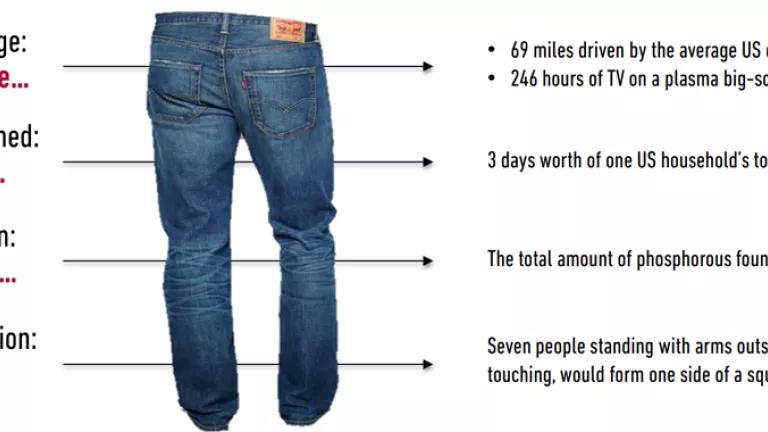21 Easy Swaps to Save Money and Our Planet

The NRDC Sustainable Operations Plan is intended to reach beyond our organization’s offices. This Earth Day, it is about supporting and encouraging thoughtful people to adopt more sustainable practices from the comfort of their homes.
One of the easiest and most cost-effective practices is simply reducing consumption because all products have an environmental impact stemming from their life cycle (Figure 1). With this in mind, there many easy swaps that can be adopted today that help protect our planet while still giving you substantial cost savings.
Energy and Water Use
- Replace your light bulbs with LEDs. These bulbs last longer than traditional bulbs and use up to 80 percent less electricity, resulting in a savings of an estimated $20 per bulb.
- Reduce standby power use with a smart power strip and install a programmable thermostat. On average this will reduce your energy bill by over 30 percent.
- Contact your electricity company and request a renewable energy power source.
- Upgrade your appliances to ones that are more energy and water efficient. An ENERGY STAR dishwasher has a 9 to 25 percent lower operating cost compared to a conventional dishwasher, and it will save five times more water than hand washing.[1]
- Install low-flow plumbing fixtures. A low-flow faucet can save a home 700 gallons of water and upgrading a toilet can save $140, annually.[2] For homes where larger upgrades are difficult, simply put a plastic bottle filled with water in the toilet tank to reduce the amount of water used per flush.
Bathroom
- Reference the toilet paper scorecard. Or if you are looking for a gentler and more hygienic option, you can easily install a bidet on your existing toilet.
- When a product runs out, use it as an opportunity to switch over to a more environmentally conscious product or no product at all. There are many low waste options like: refillable dental floss, natural body luffas, and reusable safety razors.
- Opt for reusable feminine hygiene products like period panties or menstrual cups. There many powerful environmental reasons to switch to a menstrual cup and it is overall almost 90 percent less expensive than its disposable counterparts.
- Select products in glass instead of plastic.
- Make your own personal care and cosmetic products. To better understand which of your store-bought products have hazards and health concerns—and which ones you may want to make yourself-—visit EWG's Skin Deep Database. The Database analyzes the ingredients' toxicity and presents the information in an easy to understand format (Figure 2).

Kitchen
- Store your food properly so it lasts longer. Americans waste about a pound of food per person each day.
- Bring reusable bags and purchase minimally packaged goods when doing your shopping. By one estimate, emissions from producing and incinerating plastics could amount to almost 50 times the annual emissions of all of the coal power plants in the U.S.[3]
- Shop in bulk. This saves money and reduces food and packaging waste.
- When eating take out, request no single-use utensils or packets. Plastic forks, typically used for just one meal, can take up to 1,000 years to decompose.
- Join a Community Supported Agriculture program to have local produce delivered to your home.
Pet Care
- Follow tips from Zero Waste Cat and Zero Waste Dog to help reduce the ecological paw print of your pet. Pet food emits the equivalent of 64 million tons of carbon dioxide per year, globally. That is the same as a year's worth of driving for 13.6 million cars.[4]
Waste Disposal
- Build a compost bin in your backyard or find other compost options nearby. If your family composts just 50 percent of its food waste, you will reduce your greenhouse gas emissions by over 455 pounds, annually.
- Dispose of those hard to recycle items—like chip bags, toothpaste containers, and contact lenses—through TerraCycle.
- Check to see what recycling options exist in your community and find an e-Steward certified company for your electronic waste.
- Place signage above your home's waste bins to ensure you are recycling correctly. On average, about 25 percent of items placed in the recycling stream don't belong there. This contamination undermines the correct recycling habits of others and can cause recyclable items to end up in the landfill.
- Conduct a waste audit. It is one of the best ways to know how you can reduce your family's waste.
The key to successful sustainability is about behavior change, habit formation, and collective action. Your small lifestyle adjustments can inspire the people around you and accumulate to considerable savings over the long-term. Together, we can be the ripple effect that changes the world.
To learn about additional sustainable and cost saving opportunities, check out WHO’s list of mitigating actions and available financial incentives in your state.
[1] https://www.reviewed.com/dishwashers/features/please-stop-hand-washing-your-dishes
[2] https://www.epa.gov/watersense/bathroom-faucets
[4] https://www.forbes.com/sites/jeffmcmahon/2017/08/02/whats-your-dogs-carbon-pawprint/#4c789c3213a6



